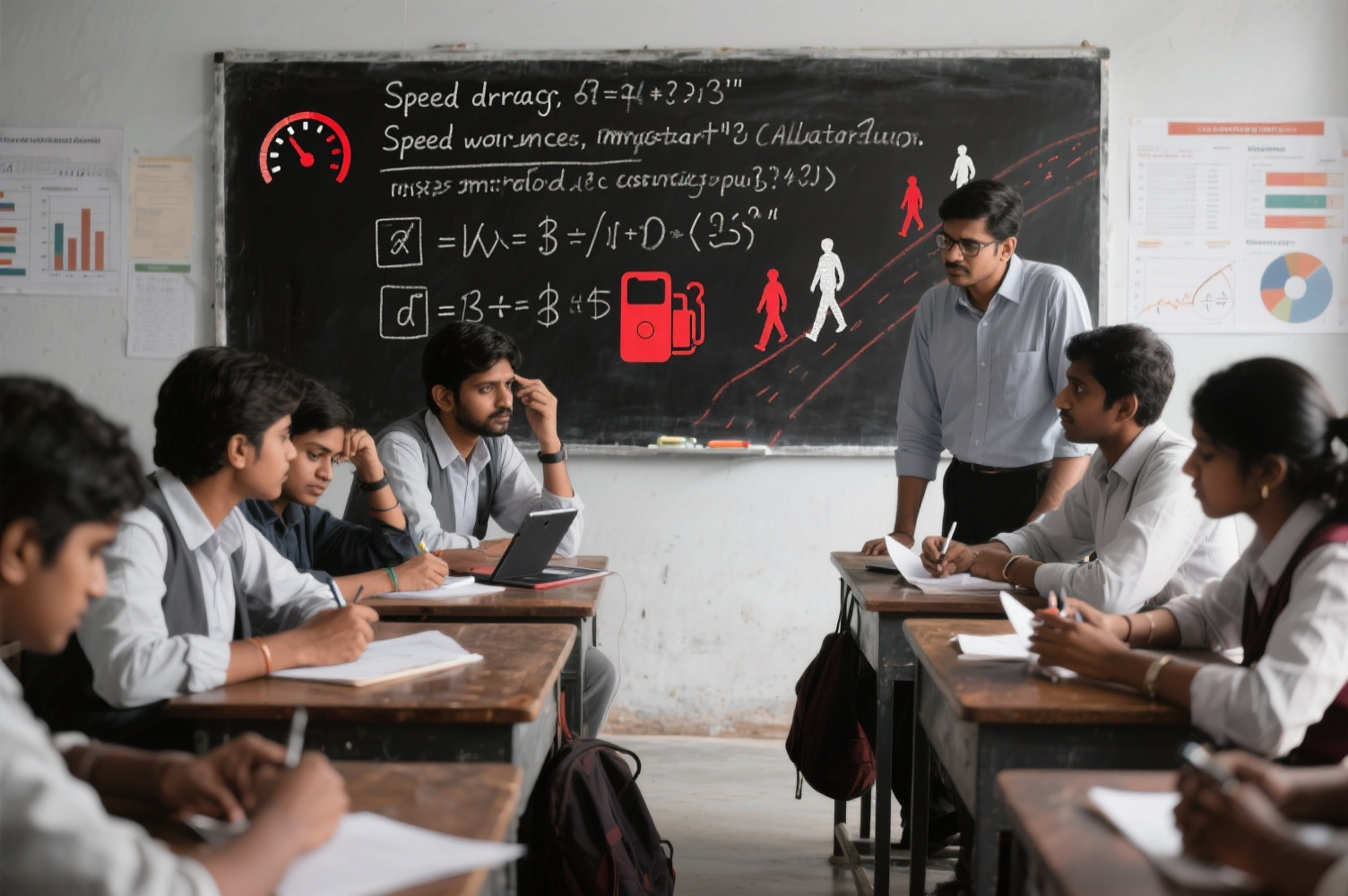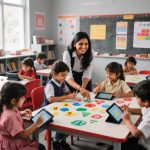- December 8, 2023
- by Educational Initiatives
- Blog
- 0 Comments
Maths is all around us. All our day-to-day activities like shopping, cooking, banking, etc. involve the application of Maths concepts. Maths is regarded as a very important subject in STEM (Science, Technology, Engineering, and Mathematics) education, and the application of Maths concepts is seen in every other field. From nurses to doctors, carpenters to architects, researchers, historians, musicians, scientists, and bankers, the application of Mathematical concepts is relevant in all the jobs that we do. So, it is necessary to transfer the Maths skills that we learn at school to solve real-life problems.
The ability to relate mathematics to real life is a common goal of school mathematics curricula in many countries (Karakoç & Alacaci 2015). According to the National Council of Teachers of Mathematics, in the United States, recognition and application of mathematics in contexts outside of mathematics is a major purpose of school mathematics. One of the ten curriculum standards of the National Council of Teachers of Mathematics in the US, ‘Connections’, refers to three different types of connections; connections of a mathematical concept to other mathematical concepts, to a field of science, or to the real world (NCTM, 2000). In England, the national curriculum effective from 2014 identifies problem-solving as one of the main aims of the mathematics curriculum. The national curriculum specifies “modelling situations mathematically” and “interpreting and solving problems including financial contexts” as targets of instruction. These aims have close connotations to real-world connections (Department of Education, U.K, 2013).
The Trends in International Mathematics and Science Study (TIMSS) assesses a range of problem-solving situations within mathematics. About two-thirds of the items require students to use application and reasoning skills. The Program for International Student Assessment (PISA) tests the application of Maths concepts covered in primary and middle schools as these are essential and compulsory skills that every individual should master “for success in education and the world of work”. The new assessment framework developed by the Central Board of Secondary Education, India (CBSE) recommends increasing the assessment of fundamental skills in real-world contexts. One of the 2 assessment objectives of the CBSE assessment framework for grades VI – X is “AO2: Apply knowledge and understanding of mathematical ideas, techniques and procedures to the classroom and real-world situations”. The framework recommends that 35% – 50% items in the grade VI assessment should test this objective and the proportion increases to 45% – 60% by grade X. The assessment objective expects students to analyse a problem, select a suitable strategy, and apply appropriate techniques.
Though many standard international assessments have increased the proportion of items from the application skill, students find this skill very difficult and perform very poorly. ASSET is a skill-based diagnostic test developed by Educational Initiatives taken by about 3.5 lakh students every year across different classes of English medium private schools in India and few Gulf countries with students of Indian origin. ASSET tests students’ conceptual understanding and a part of the test is on the application of math concepts in mathematical and real-life situations. Not more than 40% of the students answer the questions under this skill correctly. As teachers play a major role in mentoring the students and help them in developing the skill, this article discusses the proficiency of In-service Maths teachers in solving assessment items related to the objective, “AO2: Apply knowledge and understanding of mathematical ideas, techniques and procedures to the classroom and real-world situations”.
The Maths Subject Knowledge assessment data collected through the Teacher Impact Programmes (TIPS) conducted by Educational Initiatives Pvt. Ltd. was analysed to understand the teachers’ proficiency on items related to the objective, AO2. The teachers teaching in grades 3 – 10 have participated in the program and took the relevant Maths Subject Knowledge Assessment where Level 1 was designed for teachers of grades 3 – 6 and Level 2 was designed to test the subject knowledge of the teachers of grades 7 – 10. The teachers’ performance on a few items is discussed below.
| Item 1: Manjeet sells a smartphone and a digital camera at Rs 12500 each to a customer. He incurs a loss of 5% on the cost price of the digital camera and a profit of 5% on the cost price of the smartphone.
The amount of loss incurred on the digital camera is ________________ the amount of profit on the smart phone. (Hint: You may compare the two cost prices.) A) equal to B) less than C) greater than D) (cannot be said as the 2 cost prices are not known) |
Only 28.2% of 959 teachers of grades 7 – 10 answered option C which is the correct answer. 19.5% of teachers have not attempted this question. This is the 21st question out of 40 questions in the paper. So, lack of time may not be an issue in skipping this item. The above item (Item 1) involves a basic understanding of profit percent and loss percent and its application which is covered in the grades 7 and 8 curricula. They are expected to solve the question by noticing that the selling price is the same for both the items but the camera was sold at a loss whereas the phone was sold on profit. So, the cost price of the camera is greater than the cost price of the phone and the 5% of the cost price of the camera is greater than the 5% cost price of the phone. 20% of the teachers have selected option A by just seeing that the loss percent and profit percent are equal.
| Item 2: Akhil and Balu started walking along a straight path from point P to point Q, a distance of 12 km. They started at the same time and walked at a speed of 4 km/h and 6 km/h respectively. Once Balu reached point Q, he immediately turned back to walk towards Akhil and met him at point R.
What is the distance from point Q to point R? A)1.6 km B)2.4 km C)3 Km D)6 Km |
The above question (Item 2) is the application of proportional reasoning using the concept of speed-distance and time which is covered in grades 6 and 7. Only 36.7% of 1357 teachers of grades 3 – 6 selected option B which is the correct answer and 20% of them skipped the question which is the 7th question in the paper out of 40 questions. To solve the question, they need to understand that Balu reached point Q in 2 hours, and by that time Akhil covered 8 km from point P. So, they will meet somewhere between 8 km and 12 km. To find the distance of the meeting point from R, they need to divide the 4 km distance in the ratio of their speeds which is 2:3.
| Item 3: The figure here shows two isosceles triangles on the same base.
Which of the following is true regarding the angle marked x? A) x is less than 30°. B) x is more than 30°. C) x is equal to 30°. D) (cannot say without knowing the measures of other angles in the larger triangle) |
Item 3 involves applying the angle sum property of a triangle covered in grade 7. As the base angles of the outer triangle are more than that of the inner triangle, and the sum of the 3 angles is the same for both the triangles, x should be less than 30 degrees. The question can be answered intuitively also with visual reasoning and estimation. Only 37% of teachers of grades 3 – 6 and 61% of teachers of grades 7 – 10 have answered this correctly.
The performance data on the above assessment items shows that in-service Maths teachers found the skill difficult and scored low on the items related to the application of Maths concepts. Around 20% of the teachers have skipped such questions. Teachers should have a deeper understanding of the concepts they teach. Then they will be able to apply the concepts in any mathematical or real-life situations. The low performance by teachers reflects the need for teachers to improve their skills in solving such items.
The intention of the new CBSE assessment framework seems to be to improve the conceptual and application skills of students. However, it seems difficult to achieve this goal if the teachers themselves are not equipped to teach these well and help students achieve the desired learning outcome For this to be overcome, it will be worthwhile that the CBSE board and the school management have a focused approach in diagnosing the teachers’ subject knowledge and in conducting teacher capacity-building workshops to improve the teacher knowledge both in solving and creating items that test the application and understanding of mathematical ideas, techniques and procedures to the classroom and real-world situations.
The governments, educational boards, and school managements can consider some of the below recommendations to improve the teachers’ subject knowledge:
- Periodic teacher assessments that identify the learning gaps in teachers’ subject knowledge and pedagogical knowledge. The assessments should provide specific and customised feedback to the teachers based on their strengths and weaknesses in the subject. The assessment items should test the teachers’ conceptual understanding and the application of concepts rather than rote learning.
- The technology-based online assessments are a scalable option. Teachers themselves should be able to enrol and take the test online and get specific feedback on what and how to improve their abilities. For example, the report can say that “Teacher P needs more practice in applying the Maths concepts in real-life applications. Suggest to enrol in ‘Course-5’ that helps in improving the skill. The other resources that can be referred are, Resources X and Y. Or Teacher Q needs to know more about students’ misconceptions and suggest taking Course-10 etc.”.
- Designing various professional development courses that cater to the needs of different teachers and make them available online so that the teachers should be able to attend the relevant course based on the feedback provided in their assessment report. For example, a content improvement course focusing on a specific skill like problem-solving or application of Maths concepts in mathematical and real-life situations, a question-making course that tests the understanding of concepts and misconceptions, a course on identifying students’ misconceptions, etc. These courses can have different levels covering primary, middle grades, and higher-grade concepts.
- Encourage in-service teachers to take these assessments and professional development courses periodically by recognising their efforts or by linking the outcomes to their promotions etc.
EI’s working paper on teacher capacity building can be referred for more details.
https://www.ei-india.com/wp-content/uploads/2012/07/Capacity-Building-for-Teachers-Issue-13.pdf
References
Karakoç, G., & ALACACI, C. (2015). Real world connections in high school mathematics curriculum and teaching. Türk Bilgisayar ve Matematik Eğitimi Dergisi, 6(1), 31-46.




